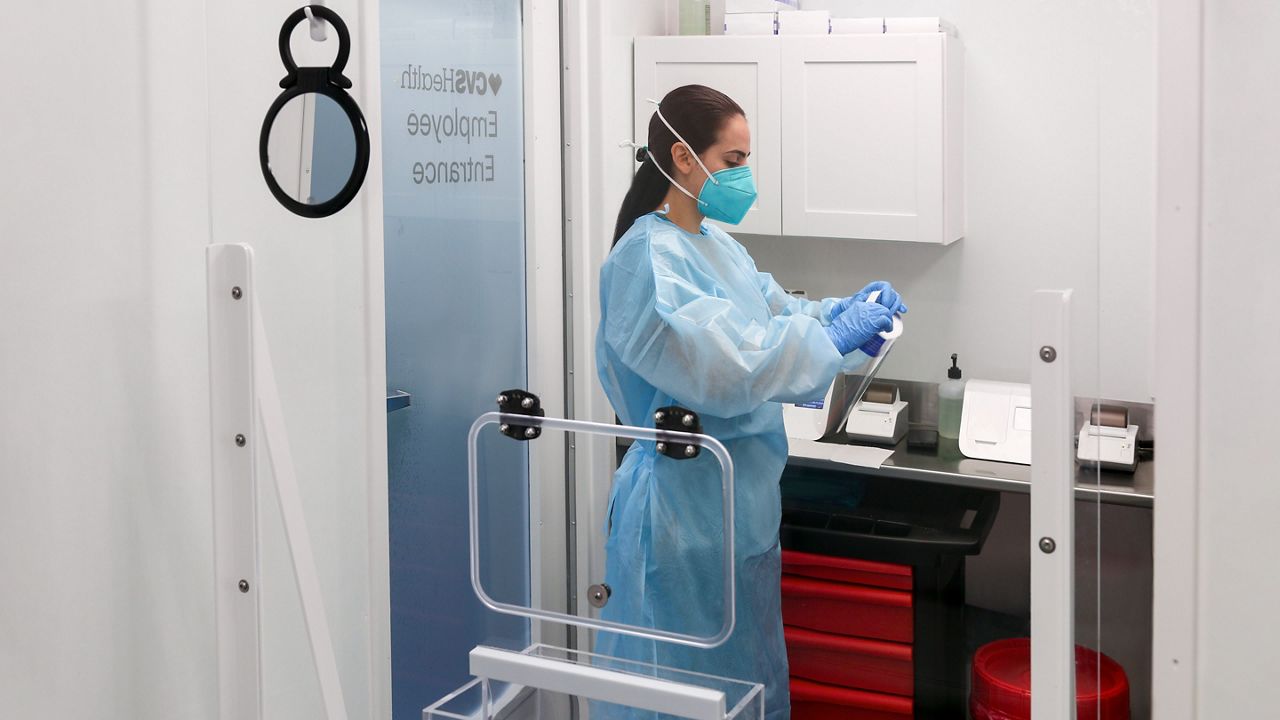COLUMBUS, Ohio — Ohio reported 25,721 coronavirus cases Tuesday on a complicated and unusual day for Ohio's coronavirus case reporting.
The jarringly-high figure is a result of the state clearing a backlog of about 13,000 positive antigen tests. It appears Tuesday's new cases would stand as a record even had the backlog not been cleared.
Tuesday's report total showed 13,993 "probable" cases, many of which were those antigen tests.
Ohio reported 11,728 new cases via PCR testing Tuesday. The day's case numbers, with antigen and PCR tests tallied, will pass the previous record of 11,885 daily cases. The state is averaging more than 700 daily cases from antigen testing, which brings the daily case total for all testing Tuesday well above 12,000.
“We will clear those backlogged antigen tests, and they will be added to our reported case counts. That will result in a one-day spike in reported cases (Tuesday), and obviously it will be a very significant spike,” Gov. Mike DeWine said Monday.
The case report Tuesday showed daily hospitalizations at 657, a dark record, and an indication the death toll is expected to rise.
Ohio reported 81 deaths, just below the seven-day average of 84.9. There were 5,181 total COVID-19 inpatients, 1,210 ICU patients, and 744 people on ventilators. The milestone of 500,000 cases was crossed Tuesday as the state makde a change to how it counts rapid testing results. Ohio had 12,600 “pending” positive antigen test results. These results have not undergone a process to link the tests to symptoms or exposure.
As of Tuesday, Ohio began automatically counting rapid test results, transitioning into sync with the Centers for Disease Control and Prevention (CDC) protocols. The cases in the backlog were added as “probable” cases.
Health departments were previously instructed by the state to put antigen tests through a “double checking” process, a measure to address the higher sensitivity of the test and greater risk of false positives as compared to PCR lab testing, which is the gold standard for accuracy.
Epidemiologists and local health department staff eventually became overwhelmed by the volume of pending antigen tests, and the amount of phone calls they had to make to confirm symptoms or exposure.
“These teams alerted us about three weeks ago that they were simply unable to keep up with the manual verification process for antigen test because there's such a wide spread of the virus throughout the state of Ohio,” DeWine said.

An Ohio Department of Health spokesperson issued a release in the afternoon explaining the day's inflated case report as the staggering numbers drew attention and questions. The statement said about 13,000 cases were cleared through the backlog, putting Tuesday's case count at about 12,721.
The state had only hit 400,000 cases 10 days ago. The seven-day average is above 9,000 daily cases.
Antigen testing is a small, but growing component of the state's testing data.
DeWine said Ohio is now averaging 12,500 antigen tests per day, and the average number of positive antigen tests has increased from 332 per day to 725 per day in the last month.
Ohio accrued a backlog of cases beginning Nov. 16 when antigen testing revved up in November at the same time as the spread of coronavirus worsened in the state.
With rapid testing, due to the sensitivity of the antigen tests, false positives are inevitable. For this reason, until today, Ohio was not automatically tabulating positive antigen tests until the state determined the individual had been exposed or developed symptoms.
Practices for use of antigen testing varies, but in general it is most useful for those who are symptomatic or exposed. In some cases, antigen tests are used for surveillance testing of asymptomatic individuals.
Other asymptomatic residents access these tests through testing services that each have their own criteria, but may only be accessible to those with health insurance and a lead on how to get a timeslot for one of the limited and coveted antigen tests.
“At the beginning of the pandemic, we had limited options for testing,” DeWine said. “We relied on PCR tests, which are considered the gold standard for tests. In the spring, the Centers for Disease Control and Prevention began accepting antigen-positive test results if they included what's called an epidemiological link
Oftentimes an asymptomatic individual who tests positive via antigen testing will seek PCR testing for confirmation it is not a false positive.
Ohio has approached antigen testing more scrupulously than other states, until the change to CDC methods was implemented Tuesday.
“After understanding more about antigen tests the CDC changed their definition in August. As a result, antigen tests, according to the CDC could be included in case counts without additional verification,” the governor said. “Tomorrow we will align with a CDC current case definition. We'll begin reflecting those tests immediately in our daily reported case counts, moving forward.”
The governor had said that all of the 12,600 tests in the backlog would "not translate into new cases.” He explained any duplicate records will be removed. It was unclear how many cases fell into this category.
The COVID-19 pandemic continues to worsen in Ohio, prompting the state to extend the 10 p.m. curfew which was set to expire Wednesday.
In Cuyahoga County, officials worried about a post-Thanksgiving spike have called in refrigerated trucks to expand morgue space. A nurse described how the hospitals have been forced to “triage” patients and more residents fall ill with the virus.



